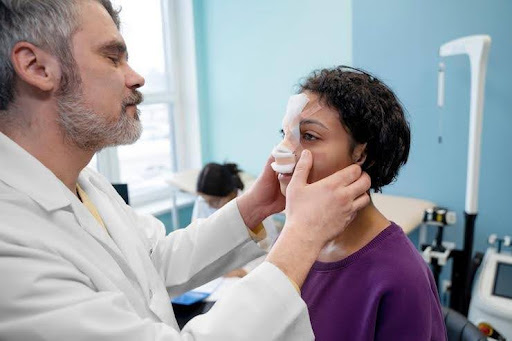Revision Rhinoplasty: Correcting Unsatisfactory Results From Previous Nose Surgery

If you’re unhappy with the results of previous nose surgery, revision rhinoplasty can help by reshaping the nose to meet your aesthetic goals. This more complex procedure requires a skilled surgeon to assess your nasal anatomy and address issues caused by scar tissue and altered structures. Choosing an experienced surgeon is key to the best outcome. Consult a reputable surgeon to evaluate your situation and achieve your ideal result.
Understanding Revision Rhinoplasty
Revision rhinoplasty is designed to correct previous rhinoplasty results, improving aesthetics and function. It is often sought for cosmetic reasons but can also address breathing difficulties. The complexity arises from changes made in the initial surgery, such as scar tissue and cartilage alterations. A skilled surgeon must understand anatomy and advanced techniques to navigate these challenges while ensuring the result aligns with the patient’s expectations and facial features.
Common Reasons For Unsatisfactory Results
Dissatisfaction with initial rhinoplasty results can arise from unrealistic expectations, where patients anticipate an outcome that doesn’t align with surgical realities. Complications like excessive tissue removal may lead to a pinched appearance, while improper healing can cause asymmetry or deformities. Functional issues, like breathing difficulties, may also prompt revision if structural concerns were not fully addressed in the original surgery. Additionally, changes over time, such as aging or trauma, can affect the nose, leading to further dissatisfaction.
Signs That You May Need Revision Rhinoplasty
Knowing when to consider revision rhinoplasty is key to achieving satisfactory results. If you’re consistently dissatisfied with the aesthetic outcome of your initial surgery and notice flaws in your nose, it may be time to consult a surgeon. Functional issues, such as difficulty breathing or changes in airflow, are also strong indicators that revision rhinoplasty may be necessary. Additionally, if your nose shifts or becomes asymmetrical over time due to aging or trauma, it’s essential to reassess the need for surgery. A qualified surgeon can help guide you through the process and determine the best action.
The Consultation Process For Revision Rhinoplasty
The consultation process for revision rhinoplasty is crucial to ensure a successful outcome. During this meeting, the ENT surgeon will evaluate your nose, listen to your concerns, and understand your goals for the revision. It’s essential to be open about your previous surgeries to help the surgeon tailor their approach. The surgeon will perform a detailed examination of your nasal anatomy, assessing the shape, size, and structural integrity of your nose while also addressing any functional concerns. Additionally, they will review your medical history to identify potential risks and provide a realistic overview of expected outcomes and recovery timelines.
Surgical Techniques For Revision Rhinoplasty
Revision rhinoplasty often requires advanced techniques to address the challenges of correcting previous surgeries. One common approach is open rhinoplasty, which involves making an incision on the columella for better access and precision. If too much cartilage was removed initially, cartilage grafting may also be used, taking cartilage from areas like the ear or rib to rebuild the nasal structure. Advanced imaging technology can further aid surgery planning, ensuring better decision-making and more accurate results. These specialized methods aim to improve the nose’s aesthetic and functional aspects.
Recovery And Healing After Revision Rhinoplasty
Recovery from revision rhinoplasty varies depending on the procedure’s complexity. Post-operative care can manage swelling, bruising, and discomfort, including rest and elevating the head to reduce swelling. Cold compresses may provide relief, and pain medication may be prescribed. Patients should avoid blowing their noses for at least a week. Swelling will decrease over time, and final results will become more apparent, though full recovery may take months. Regular follow-up appointments are essential to ensure proper healing.
Risks And Complications Of Revision Rhinoplasty
Like any surgery, revision rhinoplasty carries certain risks and complications. Scarring is a potential concern, particularly with the open technique, though skilled surgeons aim to minimize it. Infection, while rare, can occur if post-operative care is not followed correctly, with signs like increased pain, redness, or discharge requiring immediate attention. Additionally, the desired aesthetic result may not be fully achieved due to individual healing patterns or the complexity of the revision. To reduce these risks, choosing an experienced surgeon specializing in revision rhinoplasty is crucial, as their expertise plays a significant role in the outcome.
Choosing The Right Surgeon For Your Revision Rhinoplasty
Choosing the right surgeon for revision rhinoplasty is essential for success. Research board-certified surgeons with experience in revision cases, as they require specialized skills. Read reviews, schedule consultations, and compare approaches to gauge your comfort level. Ask about their experience and request before-and-after photos to ensure their aesthetic style aligns with your goals. A skilled surgeon can navigate the complexities of revision surgery and increase your chances of achieving your desired results.
Tips For A Successful Revision Rhinoplasty Outcome
To maximize the chances of successful revision rhinoplasty, it’s essential to have realistic expectations and understand that healing can vary. Communication with your surgeon is key, especially when considering Dallas cosmetic nose reshaping. Be sure to share your concerns, expectations, and previous experiences to help customize the surgical plan. Following post-operative care instructions, attending follow-up appointments, taking prescribed medications, and avoiding activities that could hinder recovery will all contribute to a smoother healing process. By staying proactive and adhering to these guidelines, you can improve the chances of achieving your desired outcome.
Conclusion
Revision rhinoplasty offers a promising solution for individuals dissatisfied with their previous nose surgery results. By understanding the complexities of this specialized procedure, recognizing the signs of revision, and selecting the right surgeon, you can take steps toward achieving your ideal nasal appearance. Although the journey may require careful planning and patience, the right expertise can help you attain the desired results. Stay patient throughout recovery and maintain realistic expectations to ensure a transformative experience. With thoughtful preparation, your dream nose may be within reach.